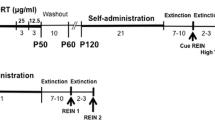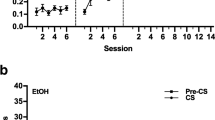Abstract
We have shown that conditioned tolerance develops to some of the behavioral and endocrine effects of nicotine in rats. Other investigators have suggested that tolerance to multiple nicotine injections in mice may be due, in part, to elevated plasma corticosterone (CORT) levels, since repeated nicotine injections are associated with elevated CORT,chronically elevated CORT reduces nicotine responsiveness and adrenalectomy disrupts nicotine tolerance. Three experiments tested the feasibility of this hypothesis, as a mechanism for conditioned nicotine tolerance in rats, by determining whetheracute administration of CORT or manipulations that increase adrenocortical activity reduce nicotine responsiveness. In experiment 1, male rats were injected IP with CORT (1 mg/kg), vehicle (ETOH + distilled water) or no injection 10 min before nicotine (0.75 mg/kg, SC) and tested for nicotine-induced analgesia every other day for 10 days. A significant reduction in withdrawal latencies was obtained for CORT pretreated rats compared to animals given only nicotine. A similar reduction was produced by the vehicle pretreatment, which itself induced an elevation of endogenous CORT. Experiments 2 and 3 established that similar effects could be produced by doses of CORT as low as 0.125 mg/kg or by exposure to a novel environment which also elevated CORT levels. Results also suggest that a conditioned release of endogenous CORT was triggered by stimuli associated with nicotine delivery. These data are consistent with the hypothesis that a conditioned release of CORT could contribute to the development of tolerance to some of nicotine's effects. The possibility that other neuroendocrine mediators might be involved in addition to or instead of CORT, is also discussed.
Similar content being viewed by others
References
Ader R (1976) Conditioned adrenocortical steroid elevations in the rat. J Comp Physiol Psychol 90:1156–1163
Antelman SM, Caggiula AR, Kocan D, Knopf S, Meyer D, Edwards D, Barry III H (1991) One experience with “lower” or “higher” intensity stressors, respectively enhances or diminishes responsiveness to haloperidol weeks later: implications for understanding drug variability. Brain Res 566:276–283
Badiani A, Pavone F (1991) Reduction of oxotremorine-induced analgesia after chronic but not acute restraint stress. Psychopharmacology 104:57–61
Baker TB, Tiffany ST (1985) Morphine tolerance as habituation. Psychol Rev 92:78–108
Bock G, Marsh J (1990) (eds) The biology of nicotine dependence. Wiley, New York
Caggiula AR, Epstein LH, Stiller RL (1989) Changing environmental cues reduces tolerance to nicotine-induced anorexia. Psychopharmacology 99:389–392
Caggiula AR, Epstein LH, Antelman SM, Saylor SS, Perkins KA, Knopf S, Stiller RL (1991) Conditioned tolerance to the anorectic and corticosterone-elevating effects of nicotine. Pharmacol Biochem Behav 40:53–59
Cochin J (1970) Possible mechanisms in development of tolerance. Fed Proc 29:19–27
Collier HOJ (1968) Supersensitivity and dependence. Nature 220:228–231
Collins AC, Miner LL, Marks MJ (1988a) Genetic influences on acute responses to nicotine and nicotine tolerance in the mouse. Pharmacol Biochem. Behavior 30:269–278
Collins AC, Romm E, Wehner JM (1988b) Nicotine tolerance: an analysis of the time course of its development and loss in the rat. Psychopharmacology 96:7–14
Collins AC, Bhat RV, Pauly JR, Marks MJ (1990a) Modulation of nicotine receptors by chronic exposure to nicotinic agonists and antagonist. In: Ciba Foundation: The biology of nicotine dependence. Wiley, New York, pp 68–86
Collins AC, Romm E, Wehner JM (1990b) Dissociation of the apparent relationship between nicotine tolerance and up-regulation of nicotinic receptors. Brain Res 25:373–379
Dilsaver SC (1988) Effects of stress on muscarinic mechanisms. Neurosci Biobehav Rev 12:23–28
Epstein LH, Caggiula AR, Stiller RL (1989) Environment-specific tolerance to nicotine. Psychopharmacology 97:235–237
Flemmer DD, Dilsaver SC (1989) Chronic injections of saline produce subsensitivity to nicotine. Pharmacol Biochem Behav 34:261–263
Gleeson RM, Atrens DM (1982) Chloropromazine hyperalgesia antagonizes clonidine analgesia, but enhances morphine analgesia in rats tested in a hot-water tail-flick paradigm. Psychopharmacology 78:141–146
Grun EU, Pauly JR, Collins AC (1992) Adrenalectomy reverses chronic injection-induced tolerance to nicotine. Psychopharmacology (in press)
Hennessey JW, Levin R, Levine S (1977) Influence of experiential factors and gonadal hormones on pituitary-adrenal response of the mouse to novelty and electric shock. J Comp Physiol Psychol 91:770–777
Hulihan-Giblin BA, Lumpkin MD, Kellar KJ (1990) Effects of administration of nicotine on prolactin release in rats: inactivation of prolactin response by repeated injections of nicotine. J Pharmacol Exp Ther 252:21–25
King DA, Bouton ME, Musty RE (1987) Associative control of tolerance to the sedative effects of a short-acting benzodiazepine. Behav Neurosci 101:104–114
Krank MD (1987) Conditioned hyperalgesia depends on the pain sensitivity measure. Behav Neurosci 101:854–857
Ksir C, Hakan R, Hall Jr, DP, Kellar KJ (1985) Exposure to nicotine enhances the behavioral stimulant effect of nicotine and increases binding of [3H] acetylcholine to nicotinic receptors. Neuropharmacology 24:527–531
Marks MJ, Burch JB, Collins AC (1983) Effects of chronic nicotine infusion on tolerance development and nicotine receptors. J Pharmacol Exp Ther 226:817–825
Marks MJ, Stitzel JA, Collins AC (1987) Infuence of kinetics of nicotine administration on tolerance development and receptor levels. Pharmacol Biochem Behav 27:505–512
Martin BJ, Wehner JM (1988) Influence of genotype on nicotine-induced increases of plasma corticosterone in mice as a result of acute nicotine pretreatment. Pharmacol Biochem Behav 30:1065–1070
Marty M, Erwin V, Cornell K, Zgombick J (1985) Effects of nicotine on beta-endorphin, alpha-MSH and ACTH secretion by isolated perfused mouse brain pituitary glands, in vitro. Pharmacol Biochem Behav 22:317–325
Matta SG, Beyer HS, McAllen KM, Sharp BM (1987) Nicotine elevates rat plasma ACTH by a central mechanism. J Pharmacol Exp Ther 243 [1]:217–226
Matta SG, Singh J, Sharp BM (1990) Catecholamines mediate nicotine induced adrenocorticotropin secretion via α-adrenergic receptors. Endocrinology 127 [6]:1646–1655
Munck A, Guyre PM, Holbrook NJ (1984) Physiological functions of glucocorticoids in stress and their relation to pharmacological actions. Endocrine Rev 5 [1]:25–44
Murphy BEP (1967) Some studies on the protein binding of steroids and their application to the routine micro and ultra-micro measurement of various steroids in body fluids by competitive protein binding assay. J Clin Endocrinol Metab 12:973–990
Paletta MS, Wagner AR (1986) Development of context-specific tolerance to morphine: Support for a dual-process interpretation. Behav Neurosci 100:611–623
Pauly JR, Ullman EA, Collins AC (1988) Adrenocortical hormone regulation of nicotine sensitivity in mice. Physiol Behav 44:109–116
Pauly JR, Ullman EA, Collins AC (1990) Chronic corticosterone administration modulates nicotine sensitivity and brain nicotine receptor binding in C3H mice. Psychopharmacology 101:310–316
Pauly JR, Grun EA, Collins AC (1992) Tolerance to nicotine following chronic treatment by injection: a potential role for corticosterone. Psychopharmacology 108 [1–2]:33–39
Peck JA, Dislaver SC, McGee M (1991) Chronic forced swim stress produces subsensitivity to nicotine. Pharmacol Biochem Behav 38:501–504
Pomerleau OF, Pomerleau CS (1990a) Cortisol response to psychological stress and/or nicotine. Pharmacol Biochem Behav 36:211–213
Pomerleau OF, Pomerleau CS (1990b) Dexamethasone attenuation of the cortisol response to nicotine in smokers. Psychopharmacology 101:284–286
Poulos CX, Cappell H (1989) Homeostatic theory of drug tolerance: a general model of physiological adaptation. Psychol Rev 98 [3]:390–408
Ratka A, Sutanto W, Bloemers M, DeKloet ER (1989) On the role of brain mineralocorticoid (type I) and glucocorticoid (type II) receptors in neuroendocrine regulation. Neuroendocrinology 50:117–123
Reisine TD, Mezey E, Palkovits M, Heisler S, Axelrod J (1984) Betaadrenergic control of adrenocorticotropic hormone release from the anterior pituitary In: Usdin E, Carlsson A, Dahlstrom A, Engel J (eds) Catecholamines: neuropharmacology and central nervous system theoretical aspects. Liss, New York, pp 419–423
Reul JMHM, DeKloet ER (1985) Two receptor systems for corticosterone in rat brain: microdistribution and differential occupation. Endocrinology 117:2505–2511
Sapolsky RM, Armanini MP, Packan DR, Sutton WS, Plotsky PM (1990) Glucocorticoid feedback inhibition of adrenocorticotropic hormone secretagogue release Neuroendocrinology 51:328–336
Schwartz RD, Kellar KJ (1983) Nicotine cholinergic receptor binding sites in brain: in vivo regulation. Science 220:214–216
Shuster L (1971) Tolerance and physical dependence In: Clouet D (ed) Narcotic drugs: biochemical pharmacology. Plenum, New York, pp 408–423
Siegel S (1975) Evidence from rats that morphine tolerance is a learned response. J Comp Physiol Psychol 89:498–506
Siegel S (1989) Pharmacological conditioning and drug effects In: Goudie AJ, Emmett-Oglesby MW (eds) Psychoactive drugs: tolerance and sensitization. Humana, Clifton, NJ, pp 115–180
Van Loon GR, De Souza EB (1987) Regulation of stress-induced secretion of POMC-derived peptides In: Ganong EF, Dallman MF, Roberts JL (eds) The hypothalamic-pituitary-adrenal axis revisited. Ann NY Acad Sci 512:300–307
Author information
Authors and Affiliations
Rights and permissions
About this article
Cite this article
Caggiula, A.R., Epstein, L.H., Antelman, S.M. et al. Acute stress or corticosterone administration reduces responsiveness to nicotine: implictions for a mechanism of conditioned tolerance. Psychopharmacology 111, 499–507 (1993). https://doi.org/10.1007/BF02253543
Received:
Revised:
Issue Date:
DOI: https://doi.org/10.1007/BF02253543




